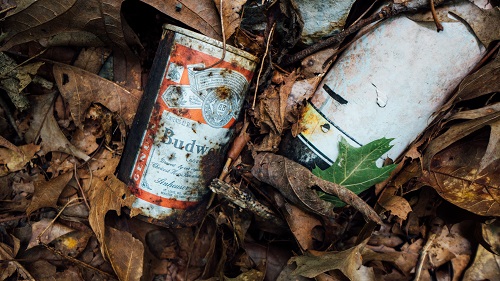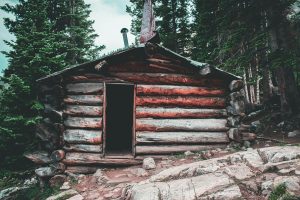By Stephen J. Lyons
I found the following untitled poem while picking up trash in the city park near the picnic pavilion:
“Our booze who art in mugs
Hallowed be thy brew
Our liquor come, we will be drunk
In bars as it is in basements
Give us this day our daily smokes
And forgive us this, our age
As we forgive those who continue to card us.
Lead us not to the Fuzz
But delivery us from authority
For thine is the booze, the babes
And the bars forever.”
This parody of the Lord’s Prayer composed by someone named “Cornbread” was hand-scrawled in black ink on a five-and-a-half by eight-and-a-half inch piece of notebook paper. Divine inspiration must have guided the author’s pen because only one line is crossed out: “If it don’t come, we will be done” was ultimately replaced by “Our liquor come, we will be drunk.” At the bottom of the paper was an initial review: “Cornbread, ain’t nothing wrong with that!” Nearby was a plastic bag containing a six-pack of Bud Light with two unopened cans.
Cornbread’s poetry is the latest treasure gleaned from my daily trash picking along the streets near my home. From high above, looking down at the patchwork agricultural fields of central Illinois, this small town appears bucolic and clean—a straight grid of tree-lined streets with a skyline of grains bins; a town square framing the county courthouse; and one lone traffic light near the soybean processing plant. But at ground level this is a dirty place. With the arrival of Hardee’s, McDonald’s, Subway, and Pizza Hut to rural America came the inevitable refuse that accompanies these questionable dietary choices.
My daily three-mile litter jog takes me past the town cemetery, a small 12-acre forest preserve and a seldom-used railroad track, then into the flat, fertile countryside. The farther from town I go, the more trash I find. Heaps of trash begets more trash. My rite of passage into this underworld came on the outskirts of a cornfield ringed by hardwoods, where I stumbled across the first syringe.
The next day I found an eight-inch vibrator complete with four working batteries. I put it in my pocket and brought it home to show my wife. Her reaction was mixed.
In the trash collecting business, trends quickly become apparent. Hardee’s is the meal of choice among litterbugs. Styrofoam coffee cups—many with half-moons of lipstick on their rims—are a frequent find, floating in weeds and stuck into bushes. Companion lids and red stir sticks are always close by, along with french fry containers, straws, unused salt and ketchup and salsa packets, and paper bags full of air. Every bit of discarded litter—including unused napkins—has the familiar Hardee’s logo on them: a crimson smiling face inside a yellow star.
McDonald’s, which also employs the red and orange colors, is a close second in road garbage frequency. One sunny Thursday at 4 p.m., I jogged past the cemetery’s entrance, a perennial resting place for beer cans, cigarette packs, green plastic bottles, and chewing tobacco tins. “Good, no trash,” I thought. At 4:15, I came back through to find a messy cache of yellow wrappers, super drink cups, and half-eaten cheeseburgers—all from McDonald’s, whose current packaging features the five-ring logo of the Olympic games. I scrounged through the bag and dug out a receipt. The culprits had bought their meals in town (a mile and half away) at 4 p.m., consumed their meals by 4:10, and tossed the remains out their car window by 4:15 at this crossroad. This may have been an Olympic record for the consumption of fast food.
If you judged our civilization only on what we threw out the windows of our vehicles, you might think that America exists solely on a diet of Marlboro Lights, Michelob, Mountain Dew, and Big Macs. With this anecdotal research in both hands, you could assume that there is a hell of a lot of people drinking and driving. You might also conclude that we’d be better off without fast food. We could eat home-cooked meals at tables with our families and we could take longer than ten minutes to eat these meals. We would be healthier and probably slimmer. And there would be a heck of a lot less trash.
Fast food debris aside, I am at a loss to explain the ten-foot tow chain I brought home. The police-style flashlight: long, black and still burning brightly. The ten-dollar bill my wife found (we bought a bottle of wine). The dismembered wall clock stuck at 11:16. Mounds of candle wax, stacks of hangers, disposable cigarette lighters, and surgical gloves. A baggie of marijuana and two loaded pipes. A vacuum cleaner. Discarded scratch-off lottery tickets. A pre-paid calling card with 14 minutes remaining. (I gave it to my daughter.) A Ramada Inn room card (no. 259). I once discovered a dead mouse inside a plastic bag, its skull crushed in a trap and its body still soft. I’ve returned a credit card, checkbook, and a library card.
A typical day’s collection is: eight cans, two bottles—either glass or plastic, a half dozen crushed cigarette packages (Camels are popular. “Turkish Gold. Pleasure to Burn.”), a fistful of gum wrappers, a trio of empty chewing tobacco tins, and several coffee cups. (Of note: Starbuck’s is gaining market share in the rural Midwest. Thank you Seattle.) There is always a “bonus find”: a perfectly constructed bologna sandwich, a Cover Girl makeup compact, a child’s plastic fireman’s helmet, a Hersey’s chocolate kiss. I found my first surgical glove in my own backyard. (I added it to my Life List of Litter.) Most of what I gather is recyclable. Some bottle and cans are not even opened. I wear gloves and I wash my hands at least twice with anti-bacterial soap when I return home.
I regularly find, but don not pick up, Kleenex, condoms, diapers, toilet paper, underwear, rust-colored Band-Aids, chemicals, cigarette butts, or smoky substances in Mason jars. I left a used oil filter in the woods because I had no way of carrying it out. I stay clear of dead crows, coons, possums, and other road kill. I keep alert for barred owls, leopard frogs, white-breasted nuthatches, green herons, black rat snakes, luna moths, white-tailed deer, mudpuppies, smallmouth salamanders, snapping turtles, and red foxes.
Last spring, following a three-inch rain, the river flooded right up to the cemetery’s access road. Flocks of Canada geese landed on the flood waters, thinking they had discovered a new lake. As I ran my regular route—my pockets already soggy from the day’s leavings—I noticed that the hardwood forest of oaks, maples, elms, and Osage orange resembled a Louisiana bald cypress swamp. The gauzy light through the trees was breathtaking. In every direction the sun sparkled like diamonds.
Then I looked closer.
In fact, the light fell upon dozens and dozens of bobbing beer cans that had surfaced from the mud during the rain. Every brand and social strata was represented from Hamms to Heineken. I have to admit it was not an entirely ugly sight.
Stephen J. Lyons is the author of four books of essays and journalism. His most recent book is “Going Driftless: Life Lessons from the Heartland for Unraveling Times.”






Be First to Comment